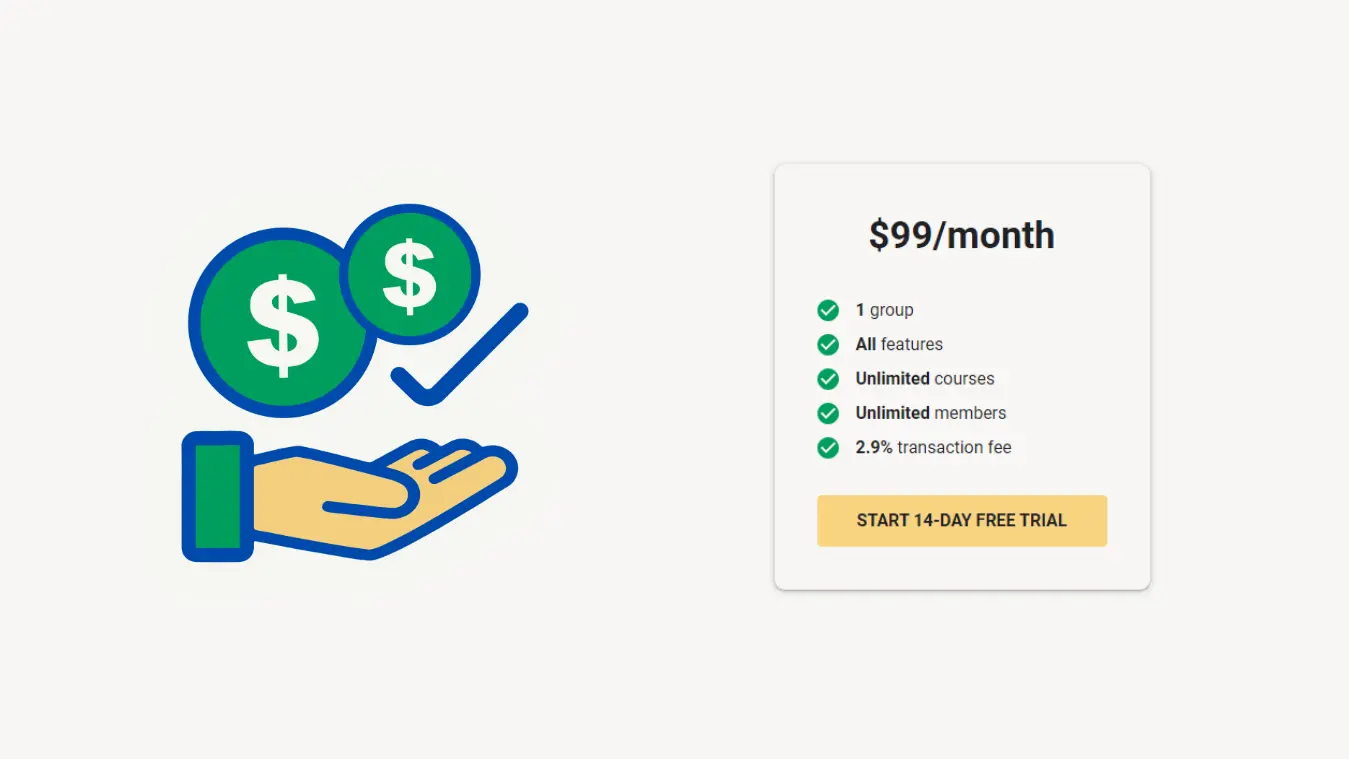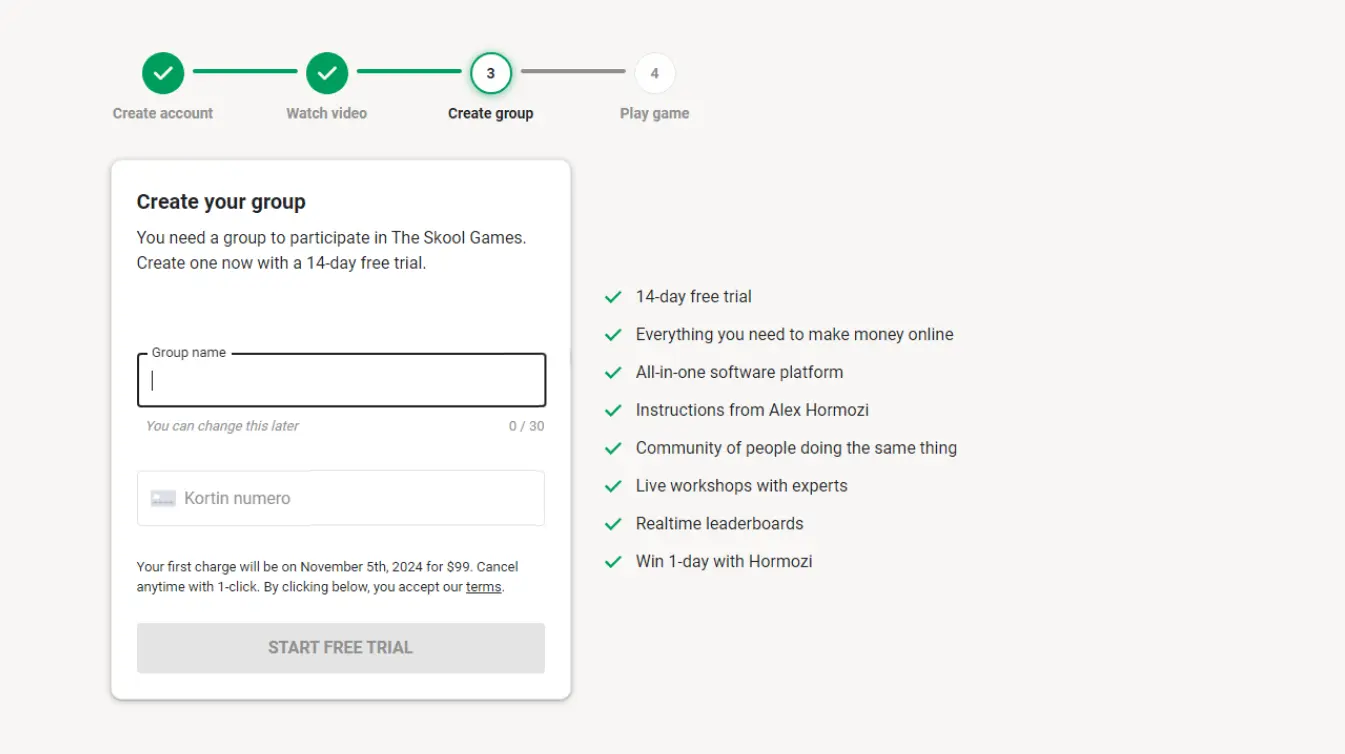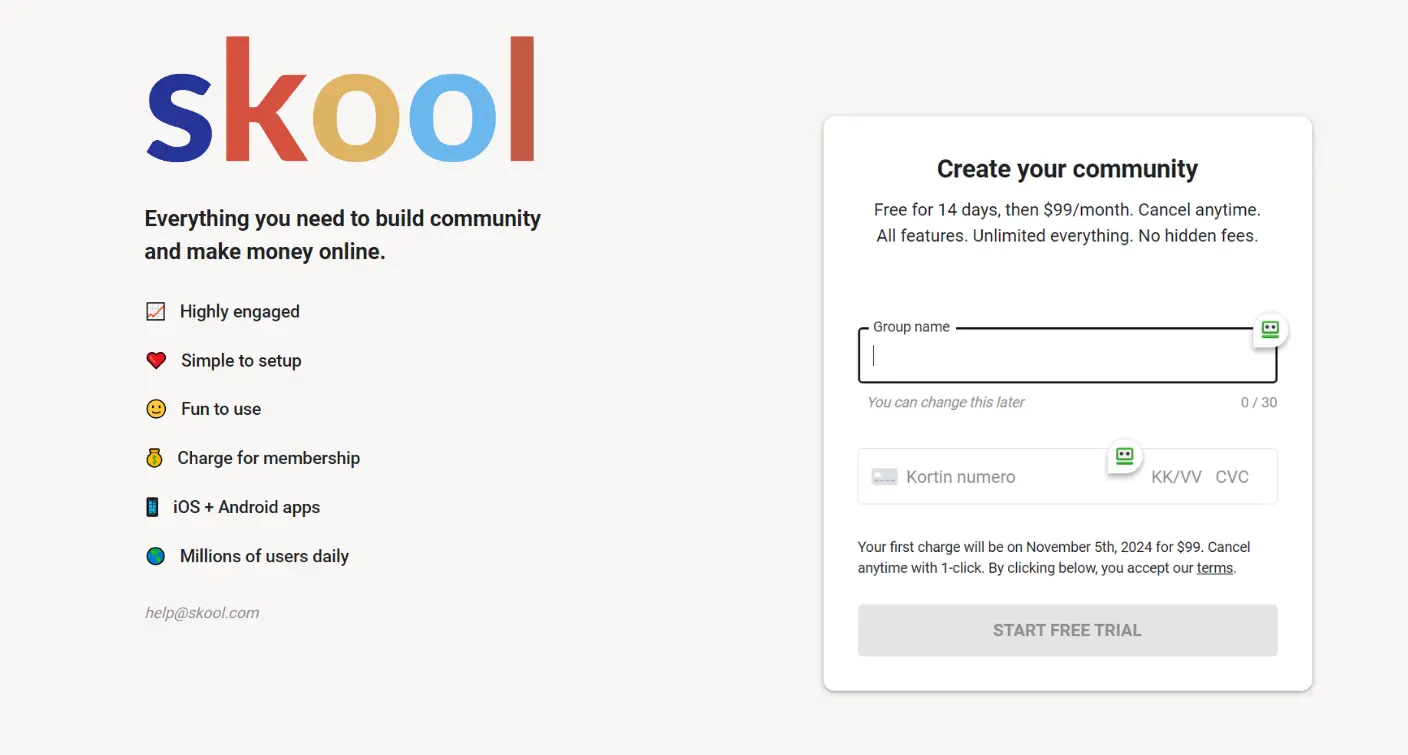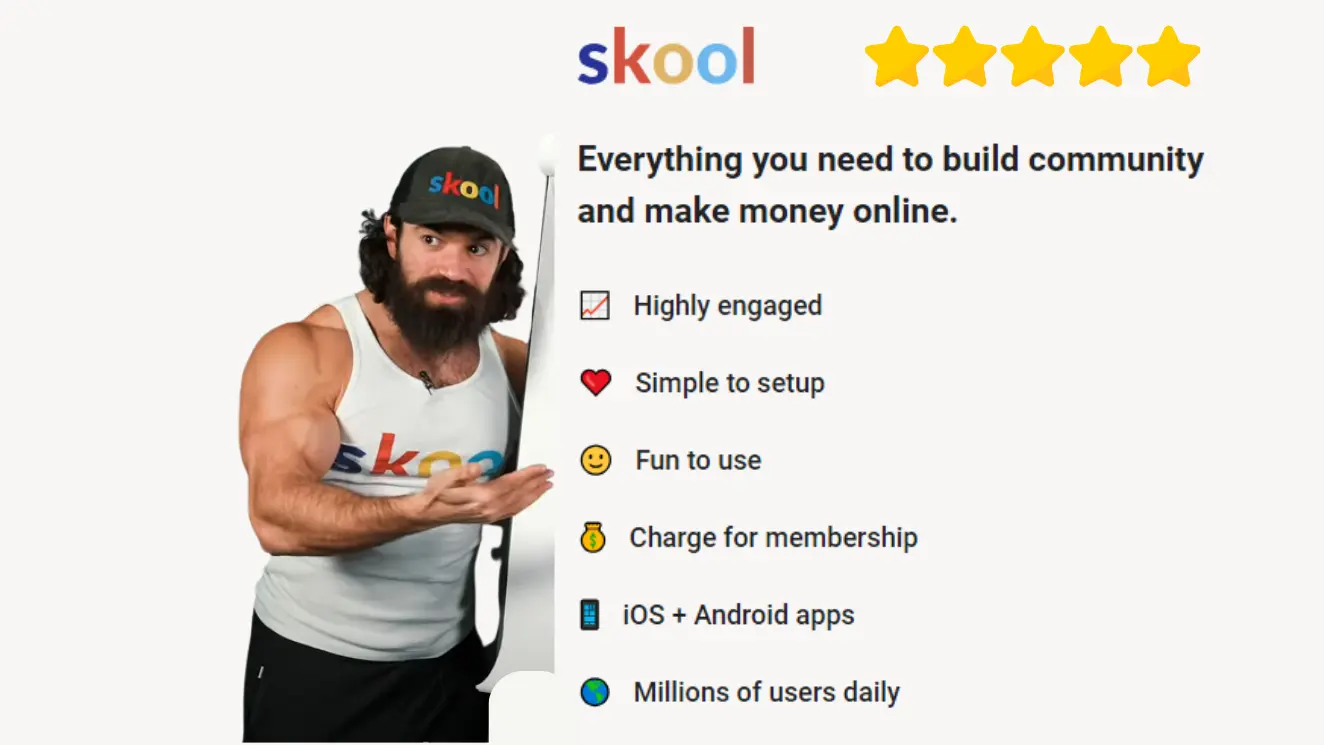Skool Pricing Plans: Is It Affordable?

Before you jump into building your community on Skool and try to win the Skool Games, it pays off to dig a bit deeper into their pricing plan and how it compares to other community & course platforms.
On top of that, you can weigh different pricing strategies for your paid group on Skool.
Let’s get started:
How Much Is Skool Pricing Per Month?
After the 14-day free trial, Skool costs you $99 per month for each group you create. So, if you have two groups for example, the monthly cost would be $198.
We like the simple pricing model, as there’s nothing complicated in this plan: You get unlimited members and all the features of the platform. You can build as many course modules as you want.
Does Skool Offer a Free Plan?
No, they only offer a 14-day free trial.
But you can use this trial time to test out the platform, grow your community and take the first steps towards earning money on Skool.
This means there’s no risk on your side testing it out.
When Does Skool Charge Me?
Once your trial has ended, Skool automatically charges the monthly free from the credit card you entered here when creating your group for Skool Games:

Skool Transaction Fees Vs Other Platforms
Skool charges 2.9% on transactions which is very low compared to other platforms.
Compare that to a whopping 16% on Discord, this fee is almost nothing - especially if you sell high ticket memberships & courses on Skool
Here’s a complete breakdown of the most common transactions fees charged on course hosting platforms:
| Platform | Skool | Stripe | Kajabi | Gumroad | Patreon | Discord |
|---|---|---|---|---|---|---|
| Transaction Fee | 2.9% | 4.9% | 4.9% | 14% | 14% | 16% |
Skool vs Kajabi Cost
Both Kajabi & Skool have 14-day free trials available.
After that, Kajabi costs you either $69, $149, $199, or $399 per month.
Buying an annual subscription saves you 20%.
The price depends on what features you wish to use & how many customers you want to have on the platform.
The cheapest option only allows 50 active customers and 250 contacts, whereas on Skool you get unlimited customers & contacts.
The programs with most features have quite a steep price for people just starting out.
Regarding features, Skool is a bit more simplistic but has everything in one place (course modules, community posts, calendar for events etc.)
Skool vs Facebook Cost
As you probably know, facebook groups are free to host.
They do have one significant downside though:
They lack engagement.
There are no gamified elements, such as leaderboards, that would encourage members to interact with each other.
Nevertheless, if your budget is tight, FB groups might be your way to start out.
Skool vs Patreon Cost
While some early adopters of Patreon have lower transaction costs, their ca 14% fee ist just quite a lot compared to Skool.
While Patreon states that their Pro plan has 8% fees & Premium plan has 12% fees of your income, they also have payment processing fees + currency conversion fees + payout fees.
So, there you have it: Unless you find some of the features on Patreon appealing compared to Skool, moneywise Skool is a much better option.
Skool vs Teachable Cost
Again, Skool keeps things simple:
- Pay $99 each month
- Make as many courses as you want
- No limits at all regarding users, course modules or feature usage
Teachable is different:
- Costs a bit more at $119 each month
- You can only create 50 courses
- After that, you’re stuck 🙁
Bottom line: If you want to create lots of courses, Skool is better.
You’ll save $20 every month and can create & host as many courses inside your community as you want.
Skool vs GoHighLevel Cost

Both platforms offer the 2 week free trial to test things out.
After that, GoHighLevel carges you $97 per month for their Starter package and $297 for the Unlimited package.
The differences here are clear:
- Skool does a whole lot of better job in offering you tools to create a vibrant community
Pricing Your Community: How to Do It The Right Way
While there are many pricing strategies that you can successfully run your Skool community on, some might suit your needs better than others right off the bat.
Let’s go from low to high:
Super Low Tier ($7-$30/month)
Best For:
- You have a large existing audience/email list
- Entry-level offer in a larger value ladder (you upsell coaching or similar service)
- Alternative to free communities (better engagement than in free communities)
- Impulse purchase positioning
Key Success Factors:
- High-value delivery despite low price point (give more than you charge)
Revenue Strategy:
- Focus on volume
- Upsell opportunities
- Backend offers
- Cross-selling potential (collaborations are good on Skool)
Low Tier ($35-$50/month)
Best For:
- Established creators with steady traffic
- Secondary offer in product continuum
- Knowledge-sharing communities
- Group coaching
Key Success Factors:
- Strong community engagement
- Regular valuable content
- Automated onboarding process in place
Medium Tier ($75-$100/month)
Best For:
- Primary offer potential
- Specialized knowledge sharing
- Industry-specific networking
- Hybrid coaching/course/community model
Key Success Factors:
- Detailed value proposition
- Structured learning components
- Regular expert interaction (if you have high authority in your niche, it helps a lot)
- Tangible member outcomes
Premium Tier ($197-$497/month)
Best For:
- Advanced training programs
- Professional development
- Industry masterminds
- Expert-led communities
Key Success Factors:
- High-touch elements
- Exclusive content/access
- Clear ROI metrics
- Professional networking
High Ticket/VIP Tier ($997+/month)
Best For:
- Elite masterminds
- Executive coaching groups
- ‘High-stakes’ problem solving
- Industry leader access
Key Success Factors:
- White-glove service for each member
- Direct access to experts
- Exclusive opportunities around the topic of the group
- Measurable business impact if the group is about business
How to Choose Your Price Point
Now this question is a tricky one, because you need to consider a LOT of factors.
Here are the steps you should take:
1. Assess Your Current Position
- Size of existing audience
- Email list quality
- Social media following
- Current offer suite
2. Evaluate Your Offering
- Time investment required
- Expertise level
- Content quality
- Access to resources/network
- Support level provided
3. Consider Your Target Market
- Income level
- Problem severity
- Solution urgency
- Industry standards
- Competitor pricing
4. Factor in Operational Costs
- Platform fees
- Content creation
- Community management
- Marketing expenses
- Support staff
Price Positioning Strategy For Skool Communities
For New Communities
- Start at a lower tier if:
- Building initial momentum
- Testing market fit
- Growing from scratch
- Limited track record
- Start at a higher tier if:
- Strong existing brand
- Proven expertise
- High-value network
- Unique offering
For Existing Communities
- Consider price increases when:
- Consistently delivering value
- High engagement rates
- Strong testimonials
- Regular waiting list
- Maintain current pricing if:
- Steady growth
- Healthy retention
- Meeting profit goals
- Market alignment
Tips & Tricks to Justify Your Skool Community Price
- Value Demonstration
- Clear benefits list
- Case studies
- ROI calculations
- Success stories
- Pricing Psychology
- Use price anchoring
- Offer payment plans
- Create pricing tiers
- Limited time offers
- Community Launch
- Founding member rates
- Early bird pricing
- Beta testing phase
- Referral incentives
- Ongoing Management
- Regular value audits
- Member feedback loops
- Pricing reviews
- Upgrade paths
Red Flags to Watch
- Excessive churn at current price point
- Low engagement despite high join rate
- Difficulty articulating value proposition
- Market resistance to pricing
- Operational costs exceeding revenue
- Competition undercutting significantly
Which Success Metrics I Should Track
- Financial Metrics
- Monthly Recurring Revenue (MRR)
- Customer Acquisition Cost (CAC)
- Lifetime Value (LTV)
- Churn Rate
- Engagement Metrics
- Daily Active Users
- Post Engagement
- Response Times
- Member Satisfaction
- Growth Metrics
- New Member Rate
- Referral Rate
- Upgrade Rate
- Retention Rate
Is Skool Worth The Price?

For people looking to build & monetize communities online, Skool is worth the money.
They offer an all-in-one community platform priced at $99 per month, which includes these key features:
- Community management features
- Unlimited course hosting
- Scheduling tools for coaching and group events
- Single platform integration
- Community engagement tools
- Course hosting capabilities
- Event scheduling system
- Direct member interaction features
They key benefits of Skool are the following:
- Members can share content & engage in discussions
- Multiple revenue stream potential through courses, coaching, and affiliate products
- Flat-rate pricing regardless of feature usage
- Integrated tools for community management
Limitations we’ve found on Skool:
- Lacks some features found in dedicated learning platforms, such as video hosting
- Limited evaluation tools for student progress (mostly progress bars)
- No built-in assessment or quiz functionality
If you’re a bit unsure whether Skool fits you, you can always take on the 14-day free trial at no cost to you.
 14-Day Free Trial Makes Joining Skool Games Risk-Free
14-Day Free Trial Makes Joining Skool Games Risk-Free